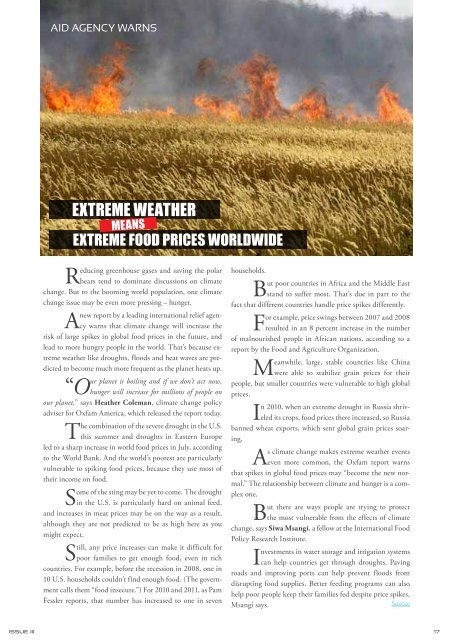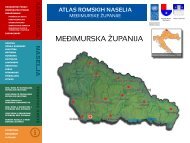Organic News 3
Organic News magazine issue 3
Organic News magazine issue 3
You also want an ePaper? Increase the reach of your titles
YUMPU automatically turns print PDFs into web optimized ePapers that Google loves.
AID AGENCY WARNS<br />
EXTREME WEATHER<br />
MEANS<br />
EXTREME FOOD PRICES WORLDWIDE<br />
Reducing greenhouse gases and saving the polar<br />
bears tend to dominate discussions on climate<br />
change. But to the booming world population, one climate<br />
change issue may be even more pressing – hunger.<br />
new report by a leading international relief agency<br />
warns that climate change will increase the<br />
A<br />
risk of large spikes in global food prices in the future, and<br />
lead to more hungry people in the world. That’s because extreme<br />
weather like droughts, floods and heat waves are predicted<br />
to become much more frequent as the planet heats up.<br />
ur planet is boiling and if we don’t act now,<br />
“O hunger will increase for millions of people on<br />
our planet,” says Heather Coleman, climate change policy<br />
adviser for Oxfam America, which released the report today.<br />
The combination of the severe drought in the U.S.<br />
this summer and droughts in Eastern Europe<br />
led to a sharp increase in world food prices in July, according<br />
to the World Bank. And the world’s poorest are particularly<br />
vulnerable to spiking food prices, because they use most of<br />
their income on food.<br />
Some of the sting may be yet to come. The drought<br />
in the U.S. is particularly hard on animal feed,<br />
and increases in meat prices may be on the way as a result,<br />
although they are not predicted to be as high here as you<br />
might expect.<br />
Still, any price increases can make it difficult for<br />
poor families to get enough food, even in rich<br />
countries. For example, before the recession in 2008, one in<br />
10 U.S. households couldn’t find enough food. (The government<br />
calls them “food insecure.”) For 2010 and 2011, as Pam<br />
Fessler reports, that number has increased to one in seven<br />
households.<br />
But poor countries in Africa and the Middle East<br />
stand to suffer most. That’s due in part to the<br />
fact that different countries handle price spikes differently.<br />
For example, price swings between 2007 and 2008<br />
resulted in an 8 percent increase in the number<br />
of malnourished people in African nations, according to a<br />
report by the Food and Agriculture Organization.<br />
Meanwhile, large, stable countries like China<br />
were able to stabilize grain prices for their<br />
people, but smaller countries were vulnerable to high global<br />
prices.<br />
I<br />
n 2010, when an extreme drought in Russia shriveled<br />
its crops, food prices there increased, so Russia<br />
banned wheat exports, which sent global grain prices soaring.<br />
As climate change makes extreme weather events<br />
even more common, the Oxfam report warns<br />
that spikes in global food prices may “become the new normal.”<br />
The relationship between climate and hunger is a complex<br />
one.<br />
But there are ways people are trying to protect<br />
the most vulnerable from the effects of climate<br />
change, says Siwa Msangi, a fellow at the International Food<br />
Policy Research Institute.<br />
Investments in water storage and irrigation systems<br />
can help countries get through droughts. Paving<br />
roads and improving ports can help prevent floods from<br />
disrupting food supplies. Better feeding programs can also<br />
help poor people keep their families fed despite price spikes,<br />
Msangi says.<br />
Source<br />
ISSUE III 17






